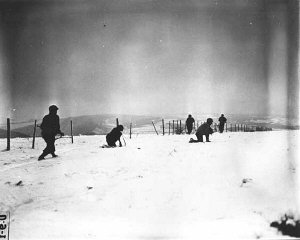


John Perry, a movie photographer with Unit 129, films GIs of the 290th Infantry Regiment, 75th Infantry Division, and 4th Cavalry Group ferreting out German snipers near Beffe, Belgium. Twelve Germans were killed. The scene was photographed by Carmen Corrado of the 129th. January 7, 1945. US Army Signal Corps photograph taken by C.A. Corrado.
— National Archives and Records Administration, College Park, Md.
As the Allies attempted to penetrate across the western border of Germany in late 1944, the Germans tried one last gambit to reverse their fortunes. Operation “Watch on the Rhine” was intended to split British and US forces in northern France.
Attacking through the Ardennes Forest in eastern Belgium on December 16, hundreds of German tanks and several hundred thousand German troops broke through the thinly held American lines. Although the Germans advanced as much as 50 miles in some areas, the Ardennes offensive was short-lived. Despite taking dreadful losses, US forces managed to delay the enemy sufficiently to permit reinforcements to be moved into position to halt the German drive. By December 26, it was clear that the German advance had been halted short of its objective, the Meuse River. In some sectors, such as the vital Elsenborn Ridge, German troops failed to make significant progress at all. On that same day, December 26, 1944, US armored troops reached the beleaguered defenders of a vital road junction in the town of Bastogne.
In large part, it was the tenacious defense put up by American soldiers, fighting in small groups in sub-zero cold and snow that stopped the German advance. This was all the more remarkable since many of the US units fighting in the Bulge had taken heavy casualties in the Hürtgen Forest fighting in the autumn of 1944.
After enlarging the corridor to Bastogne at the end of December, US troops and some British troops counterattacked to eliminate the Bulge, with the US First Army attacking from the north and General George Patton's Third Army from the south. In the face of increasing Allied pressure, the Germans began to withdraw from the Bulge on January 8, 1945. The 11th Armored Division, which was a part of the Third US Army, joined forces with the 2nd Armored Division and the 84th Infantry Division of the First Army at Houffalize, Belgium, about 20 miles east northeast of St. Hubert, on January 16, 1945. The American advance continued, eliminating all German gains by the end of January 1945. Without halting, US forces challenged the German defenses of the Siegfried Line, now undermanned after the heavy German losses during the Ardennes offensive. The Battle of Germany lay ahead.
During the Battle of the Bulge, the Germans suffered more than 100,000 casualties; the Americans approximately 81,000.
D-Day »
Hürtgen Forest »
Remagen »
The Rhine Crossings »
Encircling the Ruhr »
See related products in Museum shop »